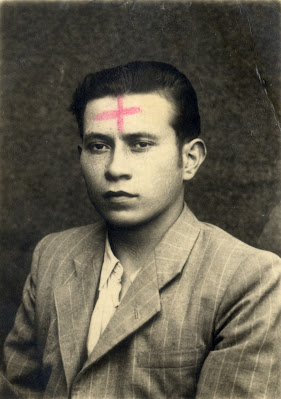 |
By Beata Bartecka & Łukasz Rusznica.
|
Curated by Beata Bartecka & Łukasz Rusznica
Palm* & OPT, 2021. 304 pp., 7¾x10½".
How To Look Natural in Photographs comes out of a 2014 exhibition curated by Beata Bartecka and Łukasz Rusznica, which featured surveillance photographs made by Polish secret police during the Communist Era. The duo discovered the photographs, and thousands more, in Poland’s Institute of National Remembrance. The book expands on the exhibition with a remarkable sequence of images and an illuminating essay by the historian Tomasz Stempowski.
The book takes its title from an instructional manual used to train officers in making mugshots. The secret police guide suggests that mugshots are best taken by surprise, so that subjects don’t have the opportunity to alter their facial expressions. A natural-looking expression makes people more easily identifiable to surveillance officers on the street. The guide warns: “Even slightly puffed-out cheeks, retraction or protrusion of the chin, or a grimace may cause changes in appearance.” Most chilling is the recommendation to make the subject comfortable in front of the camera; this mirrors exactly the advice given to photographers creating any kind of portrait. Naturalness has been prized in portraits since the nineteenth century, but this book reveals that the goals of accurate, naturalistic representation can be used to achieve varied ends. The book, and especially Stempowski’s essay, is rich with moments like this where photography reveals itself to be a tool that can be used equally for good or evil.
 |
 |
The secret police photography program began in 1946, concentrating first on photographing known subjects under surveillance, before expanding to include the general surveillance of Polish citizens in 1950. Photographic procedures were standardized in 1956 and a 10-week training course was developed to prepare agents for their photographic assignments. The officers had training in photographing altercations and people entering or exiting buildings, all subjects that appear frequently in the book. Stempowski also notes that the “surveillance section was often criticized for its lack of skill in producing actionable photographs.” There are many prints of peoples’ backs, some of which are labeled with grease-pencil numbers, which seem to uncannily mark them for punishment.
The image sequence is rich and evolving. Without accompanying text, many of the photographs seem innocuous at first. The book begins with an interior in a small cottage marred by mold or abrasions on the print surface. These white blooms are followed by a bouquet of white flowers, then a blonde boy sitting next to crates of Coca Cola. Then a pile of men’s boots next to an open safe. Bartecka and Rusznica intersperse mundane shots of evidence with images of people, sometimes photographed surreptitiously, sometimes in mugshots. At first the book is reminiscent of Larry Sultan and Mike Mandel’s Evidence, full of mystery and strange play. But, there are also photographs in How To Look Natural In Photographs that make it shockingly, irrevocably real: an apparently headless body in a wheelbarrow, many officers displaying wounds, more disfigured corpses. These pictures are all the more poignant for being set alongside the banal images of evidence: a jacket, a telephone pole, a briefcase.
As Stempowski argues, these photographs now represent a crucial chapter in the country’s collective memory. Not only do they document how the country suffered under Communist rule, but they also document the country period. Whereas in the US, there are scores of archival images that document periods of protest and civil unrest, whether its Dorothea Lange’s photographs of the General Strike in San Francisco or photographs of the Civil Rights movement. In Poland, outside of family photographs, national events are remembered by propaganda photos. The book is an unsettling and necessary reminder of photography’s complicity in these deadly decades.
Purchase Book
Read More Book Reviews
 |
 |










